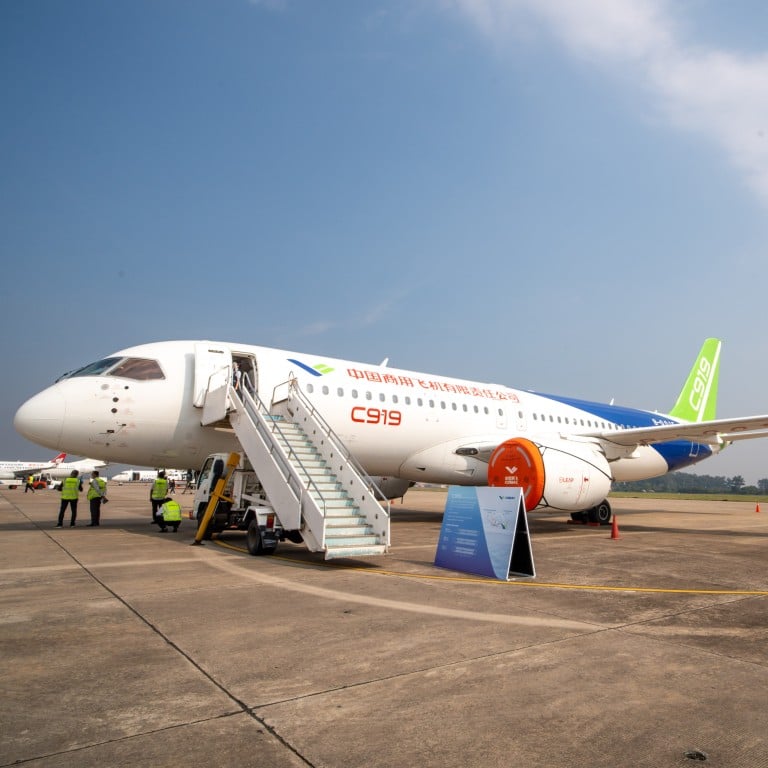
China’s C919 jet gets new route as development for widebody sibling rolls on
- The C919, China’s home-grown passenger jet, will fly a third commercial route in a show of confidence for the showpiece aircraft
- Plane has made numerous overseas debuts and demonstration flights in recent months, indicating Beijing’s international ambitions
China has launched a new route for the C919 – China’s home-grown narrowbody passenger jet – a move that will expand its commercial footprint, bolster the country’s push for self-reliance in civil aviation and contribute to its quest to meet economic targets for the coming year.
Beijing is also positioning its widebody C929 to break the duopoly of Boeing and Airbus, the current giants of the industry, with plans for construction of a manufacturing hub in Hangzhou for the in-development passenger aircraft this year. The project was officially unveiled by the city, capital of Zhejiang province, in an announcement issued last month.
The narrowbody C919, which first entered commercial operations last May, will start the new route on Friday, according to China Eastern Airlines’ online ticket booking system.
Two daily round trips will be flown by the aircraft between Shanghai Hongqiao International Airport and Xian Xianyang International Airport, an addition to the plane’s route map made shortly after the airline added a fifth C919 to its fleet on Saturday.
China has made the C919 its poster child for entry into the highly sophisticated and competitive civil aviation sector, part of an overall plan to demonstrate its capabilities in advanced manufacturing spurred largely by a wide-ranging technological rivalry with the US.
Developing the industry was identified as a major target for the new year in a work report by Premier Li Qiang, delivered on Tuesday during the annual meetings of the country’s top legislature and political advisory body, known as the “two sessions”.
And in an effort to boost international sales and exposure, the state-owned Commercial Aircraft Corporation of China (Comac), the plane’s manufacturer, brought the jet to last month’s Singapore Airshow for its overseas debut.
China’s C919 spreads its wings in Singapore, international bow lands 40 orders
However, industry experts present at the two sessions said Beijing still needs to step up its campaign for broader adoption of the aircraft, both domestically and internationally.
Li Yangmin, general manager of China Eastern Airlines and a member of the Chinese People’s Political Consultative Conference, has submitted a proposal to the advisory body stating there needs to be “a continuous boost to the core competitiveness” of the C919 in the next phase of the jet’s commercial operations.
“There needs to be more comprehensive support to make Chinese aircraft competitive on a global level,” Li said, according to an official readout. “To be successful in the market, we need more effort in developing our repair system for aircraft parts, operation insurance and commercial operations.”
One recent sale, agreed with Tibet Airways last month, involved a new variant of the C919 to suit high-altitude plateaus, a signal the company would be working on a wider range of models.
For Chinese aircraft to be widely adopted, we need to work on the technology of the products and on the supply chain
Shan Xiaoming of the Hunan Aviation Power Plant Research Institute – also attending the two sessions as a delegate to the National People’s Congress, the top legislature – shared similar views, saying sales of the C919 would be only a “first step” to access the global civil aviation market.
“For Chinese aircraft to be widely adopted, we need to work on the technology of the products and on the supply chain,” Shan said. “There needs to be autonomy in our development of engines, airborne systems, avionics systems, seating and even ground systems, so that we can drive related industries.”
While the C919 has been touted as a home-grown jet, many parts were produced by foreign suppliers. Officials said the jet was a demonstration of “win-win” cooperation through global collaboration, but the country now faces pressure to boost its capacity for next-generation manufacturing as Washington has imposed hefty trade curbs on top-end tech – aviation applications included.
To make progress on that goal, Comac said at an industry forum last December that it was aiming for half of the C929’s structural composite materials to be designed and manufactured domestically.


